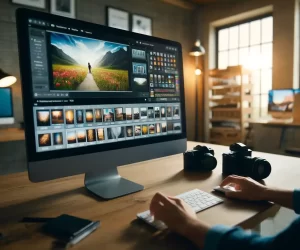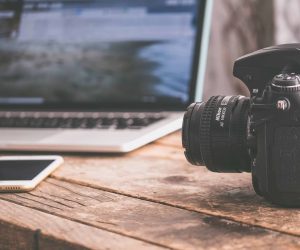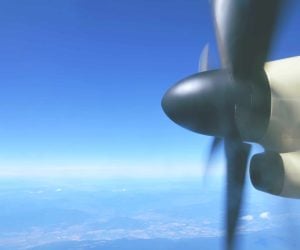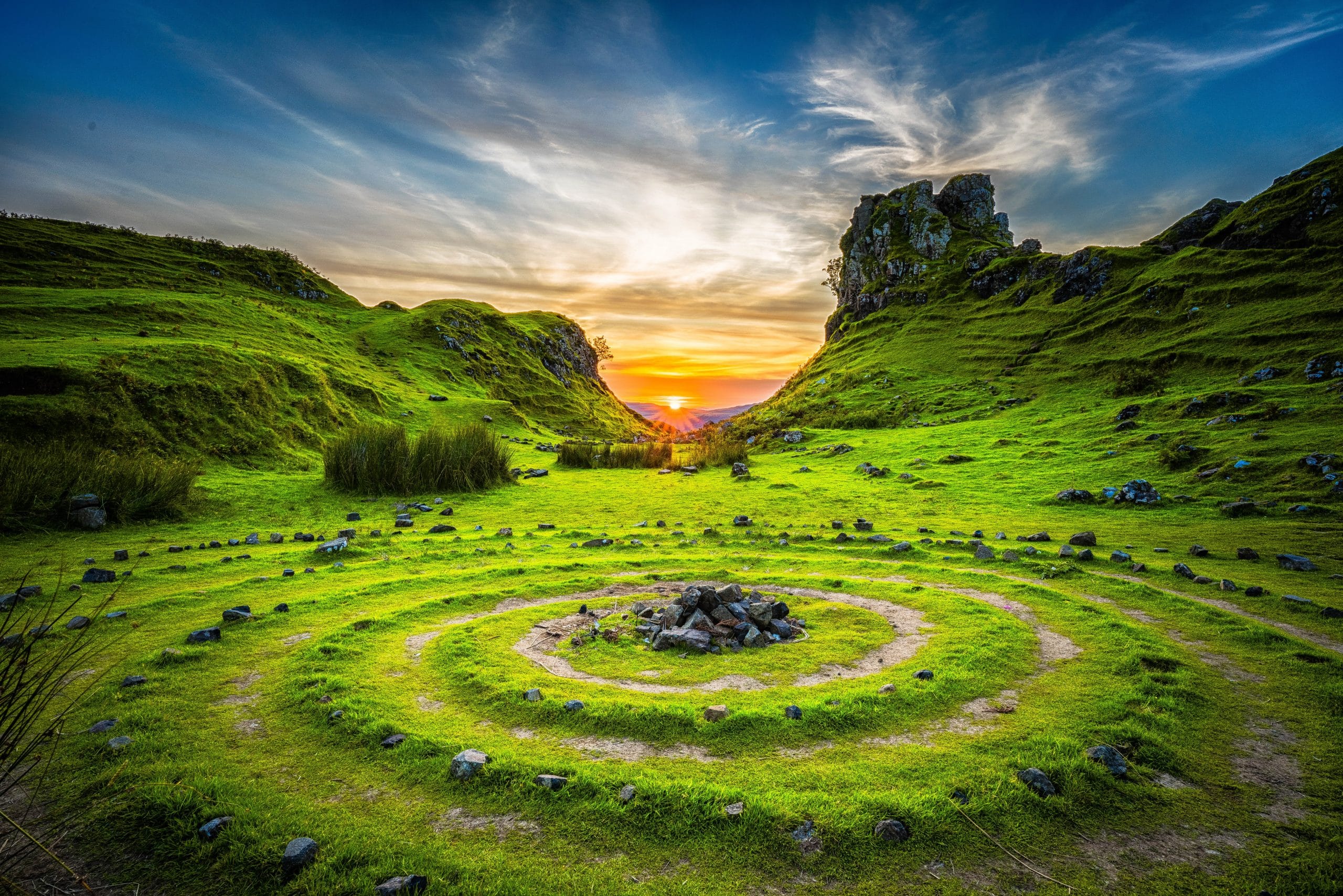
Introduction to Landscape Photography Cameras
Landscape photography is like painting a picture of nature with a camera. From grand mountains to delicate flower fields, landscape photographers use their cameras to show how beautiful the world is. Nonetheless, selecting the best landscape photography cameras is crucial to get the job done. They need to have high resolution, extensive dynamic range, and the ability to handle different lighting conditions.
In this guide, we talk about what makes a camera excellent for landscape photography. We will explore various aspects such as sensor size, image quality, dynamic range, and lens compatibility. This article is for everyone who likes to take pictures of nature, whether you are just starting or have been doing it for a long time. We will give you tips to choose the right camera for capturing the beauty of outdoor scenes. So, let’s dive in.
Table of Contents
Key Features of Best Landscape Photography Cameras
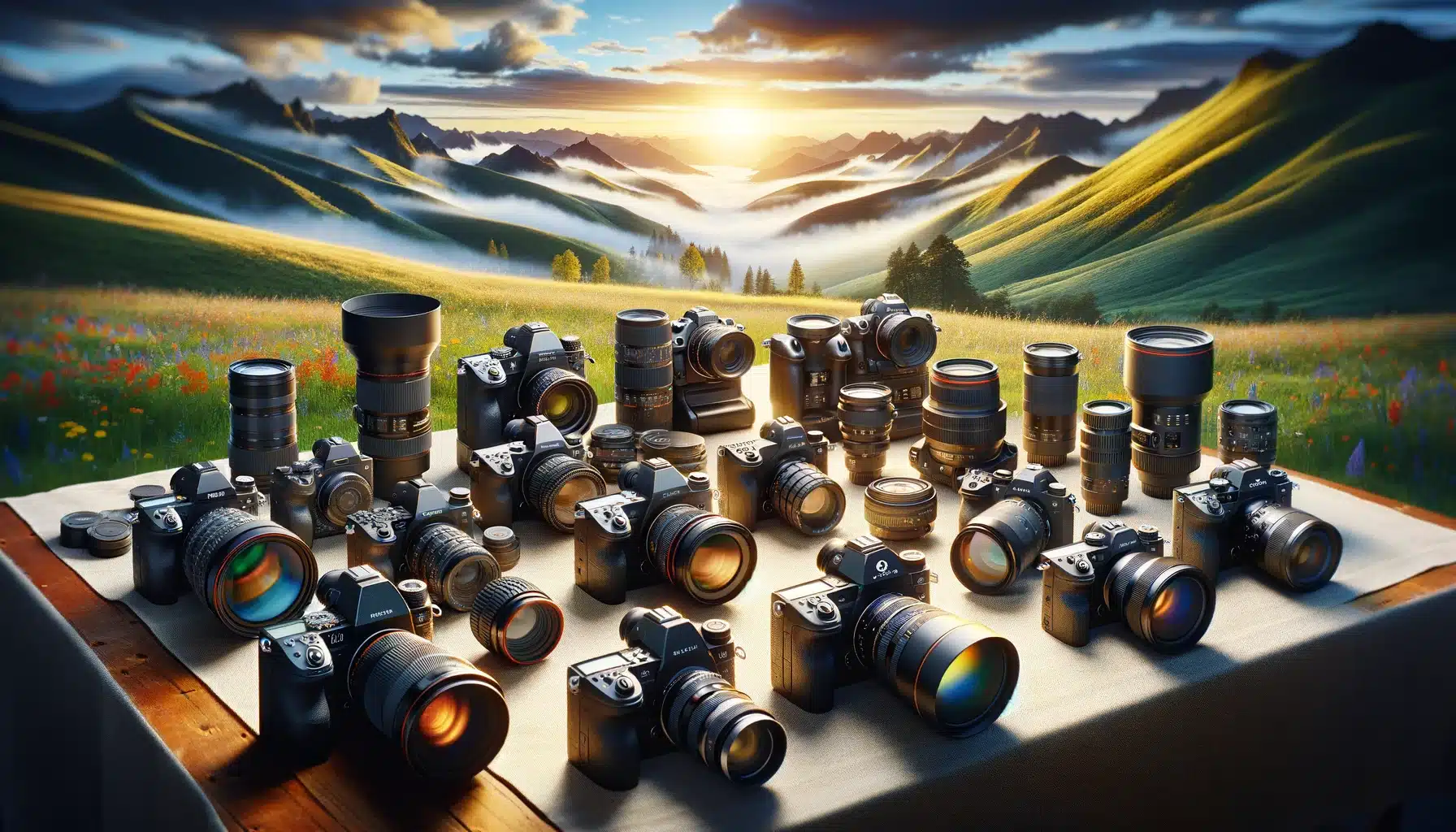
When picking a camera for landscape photography, some features make a big difference. We want our pictures to show all the beautiful colours and details we see with our eyes and these features help with just that. Let’s look at what makes the best landscape photography cameras stand out.
Sensor Size and Quality
The sensor in a camera is like its eye. The bigger the sensor, the more it can see and the better the picture will be. Big sensors, like the ones in full-frame cameras, catch more light and details. Quality sensors also help get decent colours in the photo, making everything look real and beautiful.
Dynamic Range and Color Accuracy
A great camera can see details in very bright and very dark areas, just like our eyes can. This is called dynamic range. This is important in nature photography because you often have bright skies and dark lands in the same photo.
Color accuracy is about how true the colors in your photos look compared to real life. The best cameras for scenic photography, capture all the colors of nature, from green trees to blue rivers.
Weather Sealing and Durability
When you take photos outside, your camera needs to be strong. It might rain, or the camera could get dusty. Cameras with weather sealing keep water and dirt out. This means you can take pictures in different weather without worrying about your camera getting damaged. Also, a tough camera is preferable because it won’t break easily. If you drop it or bump it, it should be okay.
The Best Landscape Photography Cameras
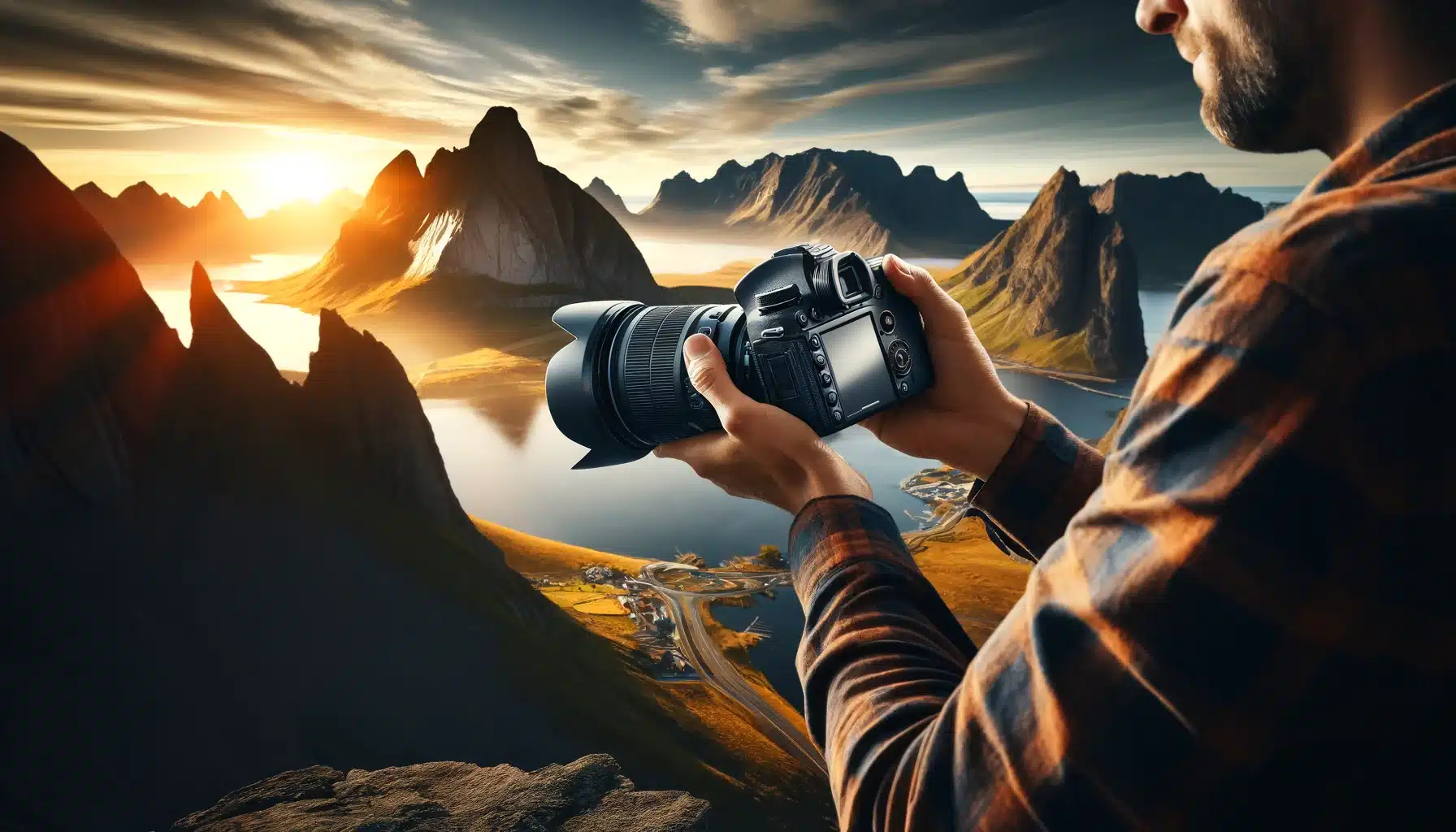
Choosing optimal cameras for landscape shots is crucial for capturing the essence of this beautiful world. Photographers need cameras that can handle varied lighting conditions, offer suitable resolution, and provide flexibility in lens choices. Here, we check out the best nature photography cameras available.
Top Picks for Professional Landscape Photographer
Sony α7R IV: A top choice for professionals, the Sony α7R IV boasts a whopping 61-megapixel full-frame sensor, providing astounding detail and clarity. With robust construction and a dynamic range that captures intricate shadows and highlights, this gear is ideal for the varied lighting of outdoor scenes.
Nikon D850: Renowned for its resolution of 45.7 megapixel, the Nikon D850 offers excellent performance in low light conditions, thanks to its back-illuminated sensor. Its comprehensive weather sealing and rich color gradations make it a favorite among landscape professionals.
Best Value Cameras for Hobbyist Landscape Photographers
Canon EOS 90D: With a 32.5-megapixel APS-C sensor, the Canon EOS 90D strikes a balance between affordability and performance. It offers excellent image quality with excellent dynamic range and is versatile enough to handle various landscape scenarios.
Fujifilm X-T4: Compact and lightweight, the Fujifilm X-T4 is perfect for hobbyists who travel. With a 26.1-megapixel APS-C sensor, it delivers impressive image quality and color rendition. Its in-body stabilization helps in capturing sharp images in challenging lighting in outdoors.
Cameras for Different Types of Landscape Photography
For expansive landscapes: Cameras like the Canon EOS R5, with its 45-megapixel full-frame sensor, offer increased resolution, ensuring that every detail of the vast scene is recorded with clarity.
For detailed nature shots: The Nikon Z7 II, with its 45.7-megapixel resolution, has the ability to focus closely, combined with a high-resolution sensor, photographing even the smallest details with precision.
Top Landscape Photography Cameras - A Detailed Comparison
Read below for a detailed understanding of the best landscape photography cameras. This table provides a clear view of how these cameras stack up against each other in terms of key features relevant to outdoor nature photography.
| Feature | Sony α7R IV | Nikon D850 | Canon EOS 90D | Fujifilm X-T4 |
|---|---|---|---|---|
| Sensor Type | Full-frame | Full-frameP | APS-C | APS-C |
| Resolution | 61 megapixelse | 45.7 megapixels | 32.5 megapixels | 26.1 megapixels |
| Image Quality | Extreme details and clarity | Excellent detail, great in low light | Very good, balanced performance | High-quality with color accuracy |
| Dynamic Rang | Maximum | Maximum | Good | Decent |
| Weather Sealing | Yes, robust against elements | Yes, built for rugged use | Yes, reliable for outdoor use | Yes, but less rugged than DSLRs |
| Portability | Portable, typical for full-frame mirrorless | Less portable, heavier DSLR | More portable for a DSLR | Very portable, lightweight mirrorlesss |
| Price Band | Expensive, professional market/td> | Expensive, professional market | Average, great value | Average, affordable |
Comparing Mirrorless and DSLR Cameras for Landscape Photography
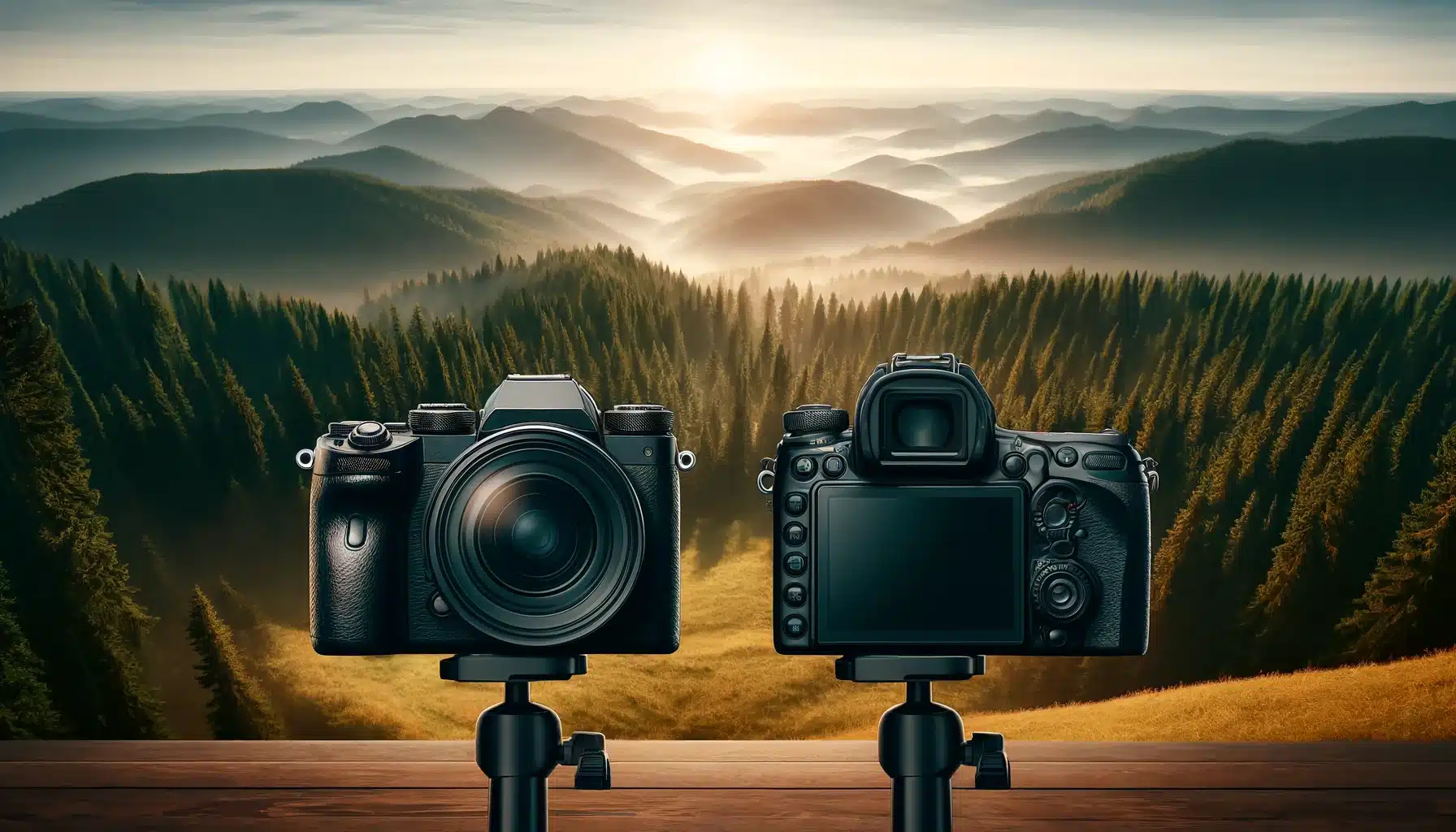
Choosing between mirrorless and DSLR cameras for best landscape photography depends on what you need for your shots. Both types have worthy points for taking beautiful landscape photos.
Mirrorless cameras are light and suitable for outdoor trips. They let you see the photo before you take it, which helps get the best shot. But, they might need more battery changes than DSLRs. The Sony α7R IV is a light mirrorless camera loved for its clear pictures.
DSLR cameras last longer without charging and they show the real scene through their viewfinder. They are heavier, which might be tough on long walks. The Nikon D850 is a strong DSLR known for great pictures and lasting build.
Let’s see how they are different and what they offer.
| Feature | Mirrorless Cameras | DSLR Cameras |
|---|---|---|
| Weight / Size | Light weight and compact, easier to carry on long hikes. | Heavier and bulkier, more stable but harder to transport. |
| Viewfinder | Electronic viewfinder (EVF) allows previewing effects and settings in real-time. | Optical viewfinder provides a clear and direct view of the scene without lag. |
| Battery Life | Shorter due to constant sensor and EVF usage. | Longer, as the optical viewfinder uses less power. |
| Image Quality | Excellent-quality images with advanced technology sensors.0 | Comparable great-quality images, with performance depending on the specific model. |
| Autofocus Speed | Fast and accurate, excellent for changing landscapes. | Very reliable, especially in well-lit conditions, but can be slower in low light. |
| Lens Compatibility | Growing variety of lenses; adapters available for other lens types. | Expansive diversity available, especially for established brands. |
Choosing the Right Camera for Landscape Photography

Picking the right camera for landscape photography means thinking about where you’ll use it and what you want to capture. You need a camera that can show the beauty of nature in detail and color. Let’s explore how to choose the perfect camera for capturing the great outdoors.
Budget vs. Performance: Finding the Right Balance
You don’t have to spend a lot of money to get the best camera for landscape photos. Start with how much you can spend, then look for a camera with excellent image quality within your budget. For example, average priced cameras like the Canon EOS 90D offer great value, providing excellent image quality without the increased cost of professional cameras.
Camera System: Lens Availability and Accessories
The camera body is just the start. Check what lenses and photographic accessories are available for it. For landscapes, you might want a wide-angle lens to capture big scenes. Make sure the camera you choose works with the lens you need for nature photography. Brands like Nikon and Canon have an expansive choice of lenses suitable for nature photography.
Lens Selection for Landscape Photography
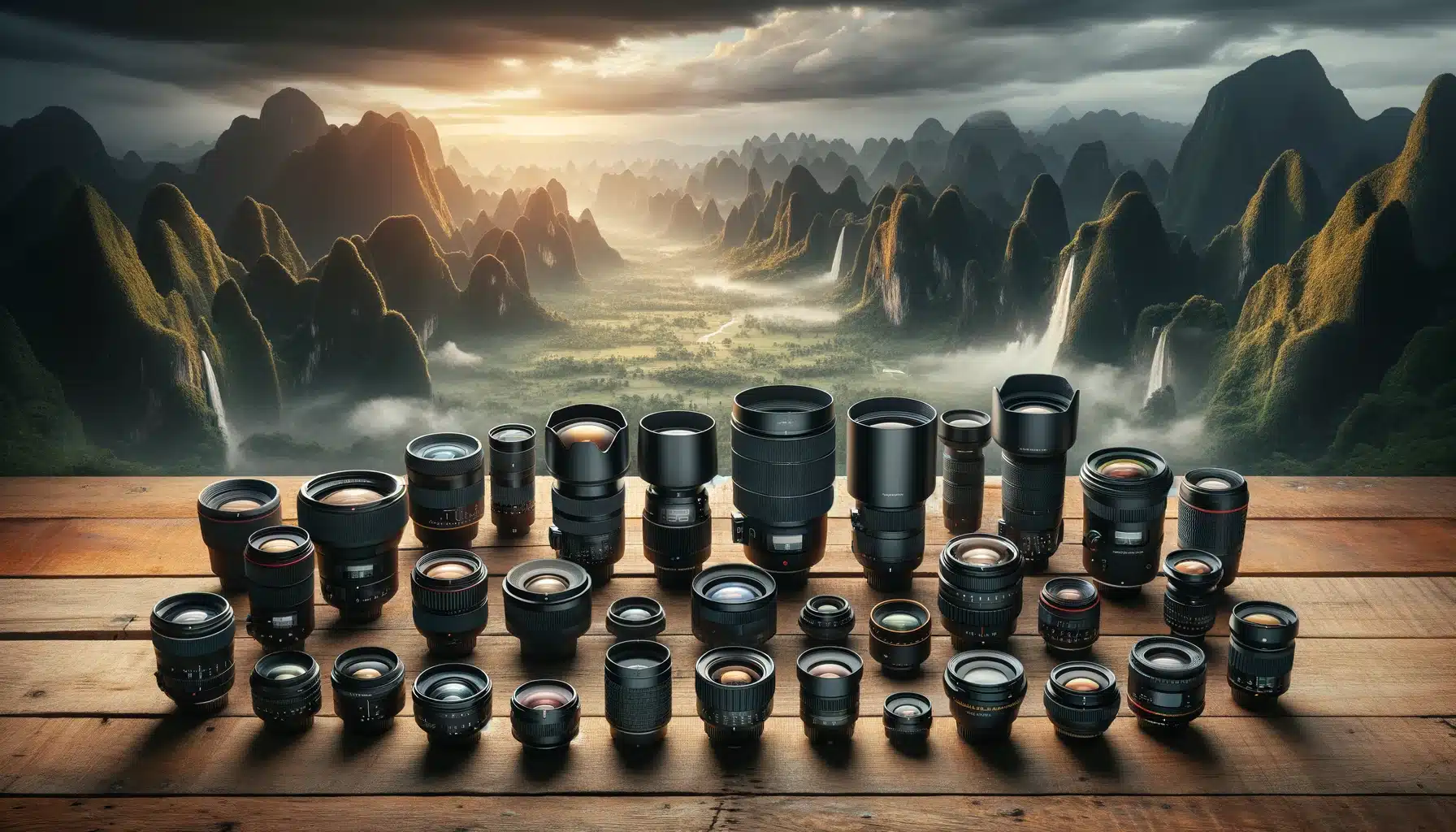
For landscape photography, choosing the right lens is as crucial as the camera itself. A lens shapes how you capture the environment, affecting the view’s breadth, detail, and perspective. Let’s learn how to choose the best lens for taking pictures of landscapes.
Wide-Angle Lenses: Essential for Expansive Landscapes
Wide-angle lens are great for big views. They let you capture large areas, like fields or mountains, making them fit in one photo. This is perfect for showing the grandness of nature, like rolling hills or wide valleys, allowing photographers to include both the foreground and the distant horizon in the shot.
Telephoto Lens: Capturing Distant Details
Telephoto lenses, on the other hand, are great for isolating and emphasizing specific features within the landscape, like a distant mountain peak or a solitary tree. They help in focusing on the details that might be lost in a wider shot.
Prime vs. Zoom Lens for Landscape Work
Prime lenses have a fixed focal length and are often sharper and faster. This feature makes them suitable for capturing detailed and vibrant landscape images. Zoom lenses offer versatility, allowing photographers to adjust the focal length to compose the perfect shot without changing their position.
Budget Considerations for Landscape Cameras
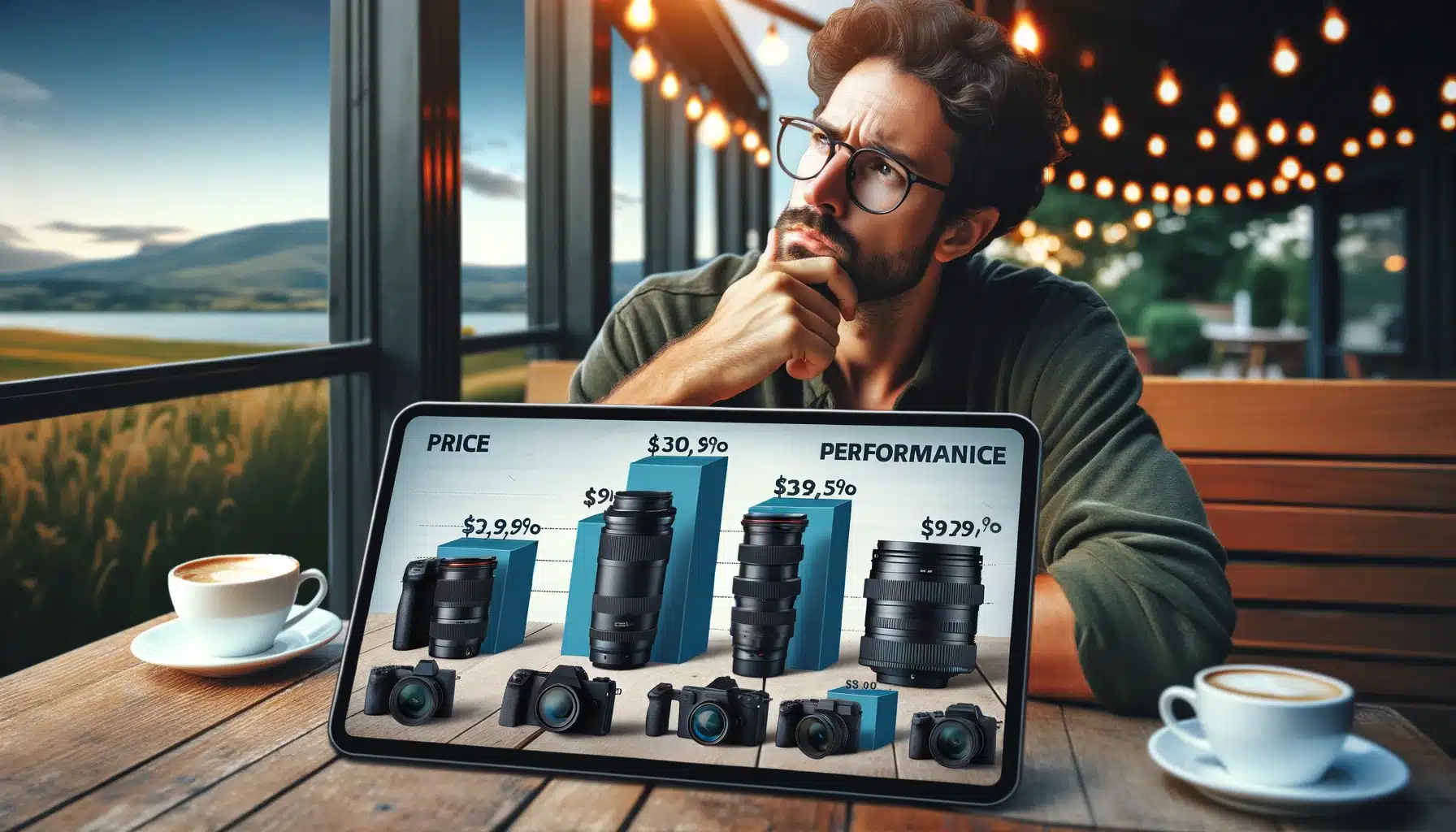
When looking for outdoor photography cameras, it’s important to think about how much money you can spend. Not all cameras cost the same, and some can be very expensive. We will look at how to choose a camera that is right for taking pictures of nature without spending too much money.
Entry-Level Cameras for Beginners
If you’re new to landscape photography, you don’t need the most expensive camera. Start with a simpler, less costly model. These cameras are easier to use and still take great photos of nature. For example, the Canon EOS Rebel series offers good quality without breaking the bank.
Mid-Range Cameras: Balancing Cost and Features
Mid-range cameras offer better features for nature photography like higher megapixel count and better ISO performance. They cost more than entry-level cameras but are not as expensive as the top models. Cameras like the Fujifilm X-T series are good options in this category.
Expensive Cameras for Professional Use
If you are very serious about landscape photography, you might want a top-notch camera. These cameras have the best features and take photos with maximum quality. They are expensive, but they are worth it for professional photographers.
Best Mobile Cameras for Landscape Photography

In today’s world, mobile phones with advanced cameras have become powerful tools for landscape photography. They offer convenience and quality, allowing photographers to capture stunning outdoor scenes. Here’s a closer look at some top choices and their features.
Apple’s iPhone 15 Pro Max
The iPhone 15 Pro Max stands out with its advanced triple-camera system, featuring 48-megapixel main camera with a 24 mm lens, 12MP ultrawide, and 12MP telephoto lenses. Its night mode and Smart HDR 5 make it excellent for capturing landscapes in various lighting conditions, producing images with exceptional detail and color accuracy. Moreover, it offers depth control and focus in cinematic mode, for magical nature shots.
Samsung Galaxy S24 Ultra
The Samsung Galaxy S24 Ultra is renowned for its versatile quad-camera setup with a 200-megapixel main sensor, providing stunning clarity and wide scenic captures. Its extraordinary 100x Space Zoom feature allows for detailed shots even at great distances, making it ideal for expansive landscapes.
Google Pixel 6 Pro
Google Pixel 6 Pro offers superb image processing capabilities, with a sensor that excels in capturing light and detail. The triple camera system with lenses equivalent to 14mm, 25mm, and 113mm and the 30x Super Res Zoom are perfect for landscape shots. Plus the Real Tone feature ensures accurate color representation in diverse environments.
Advanced Techniques in Landscape Photography
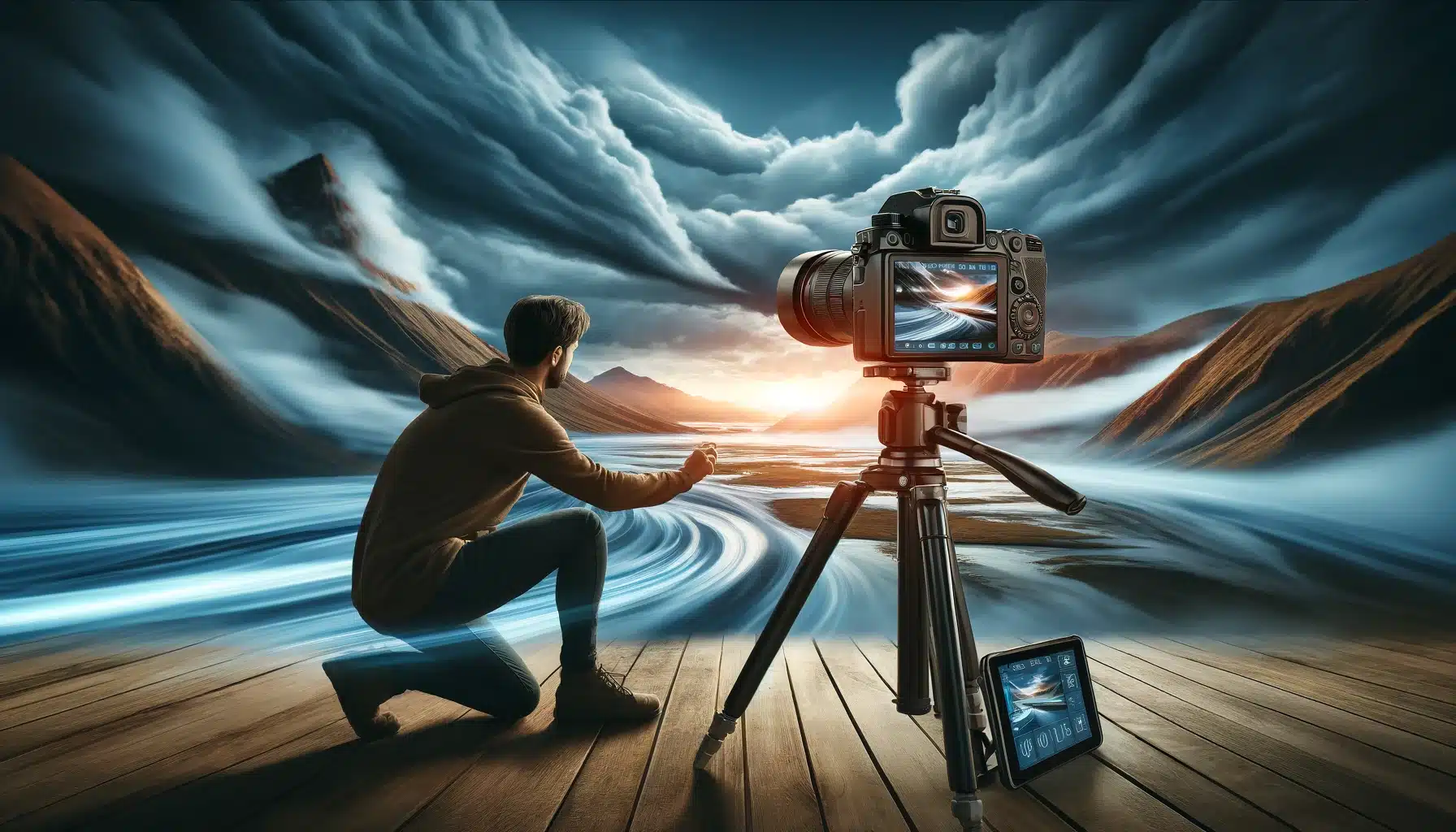
In landscape photography, using advanced techniques can help you create stunning images. These methods can add depth and drama to your photos, making them stand out.
Mastering Composition and Framing
Composition is key to great landscape photos. Use the rule of thirds to place interesting parts of the scene at intersections of the grid lines. Also, look for leading lines, like roads or rivers, to draw the viewer’s eye into the picture.
Long Exposure and HDR Techniques
Long exposure can make water or clouds look smooth and dreamy. Use a tripod and a slow shutter speed to try this. HDR, or extraordinary dynamic range, involves taking several photos at different exposures and combining them to show details in both light and dark areas.
Post-Processing Tips for Landscape Photos
Processing your photos on photo editing software like Adobe Photoshop or Lightroom can enhance colors and details. Adjust brightness, contrast, and saturation to make your images pop. Be careful not to overdo it, as the goal is to enhance, not change, the natural beauty of the scene.
Future Trends in Landscape Photography Equipment
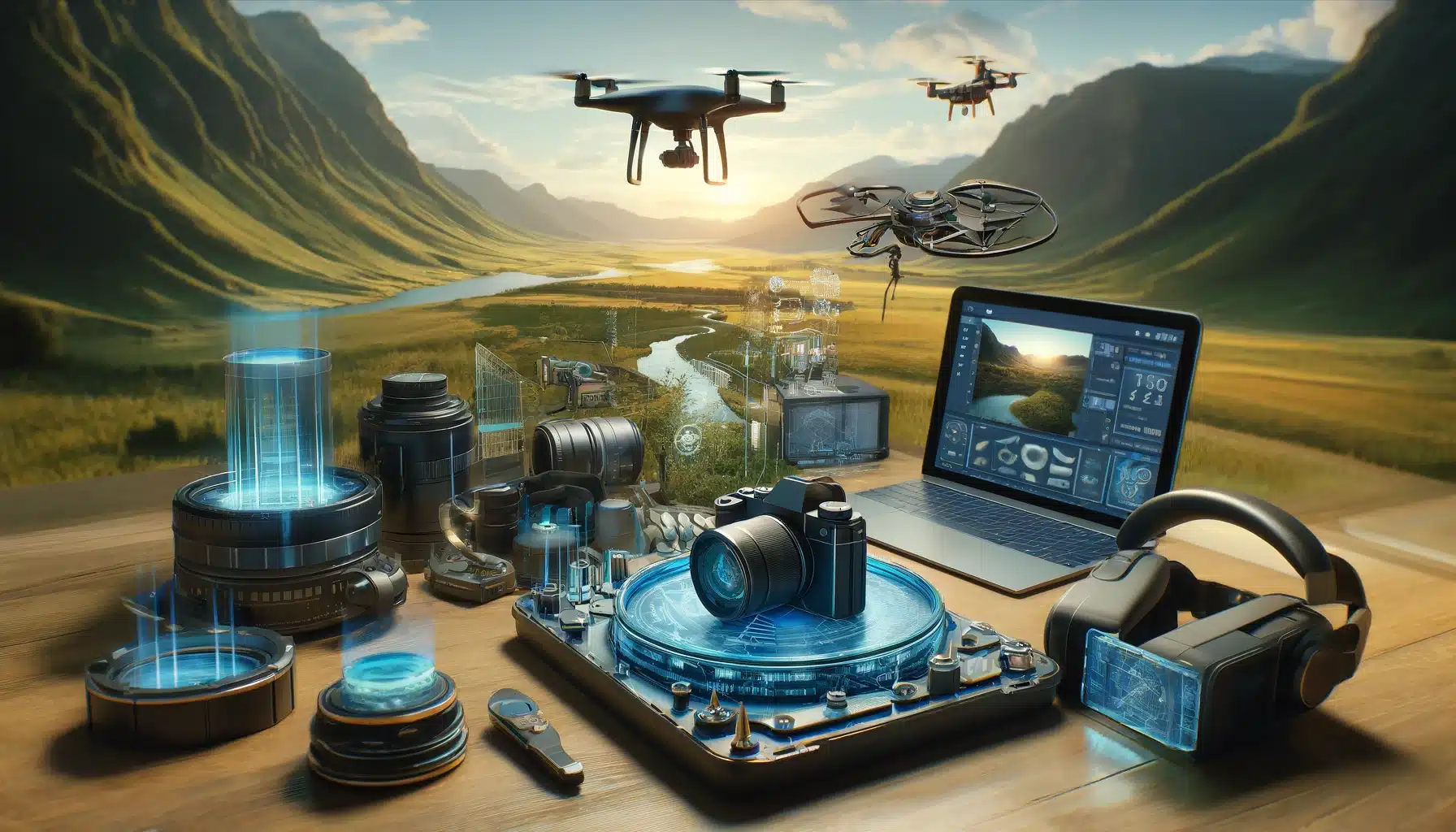
Landscape photography equipment is always changing. New technologies make cameras and lenses better for capturing nature. Let’s explore what will come next in the world of landscape photography gear.
Technological Advancements and Innovations
In the future, cameras will get even better at taking clear and sharp pictures. They might have sensors that can capture more light and detail, even in very dark or bright places. Cameras will also become lighter and easier to carry on long hikes.
Emerging Camera Brands and Models
New companies will start making more creative cameras. They will offer different features or be less expensive than the big brands. This means more choices for photographers, making it easier to find the perfect camera for taking pictures of landscapes.

Frequently Asked Questions about the Best Landscape Photography Cameras
When finding cameras for landscape photography, consider their features to capture detailed and vibrant outdoor scenes. If you are an amateur nature photography enthusiast who wants to photograph breathtaking landscape shots but is confused about the best landscape photography cameras, this section is for you.
Which camera is best for landscape photography?
The best landscape photography camera depends on the photographer’s needs. High-resolution cameras like the GFX series are excellent for capturing detailed nature scenes. Look for cameras with large sensors, high megapixels, and robust weather-sealing for outdoor conditions.
How do I choose a landscape camera?
To choose a landscape camera, prioritize image quality, sensor size, and weather resistance. Consider the weight for ease of carrying in nature and check the format compatibility with various lenses. Read about the camera or a watch video to see how good it is for outdoor pictures.
Is mirrorless or DSLR better for landscape?
Mirrorless cameras offer lightweight and compact designs, making them ideal for hiking and travel during nature photography. DSLRs provide longer battery life and durability. The choice between mirrorless and DSLR for landscape depends on personal preferences for weight, battery life, and handling.
What camera lens is best for landscape photography?
Wide-angle lens is typically best for landscape photography due to its ability to capture expansive scenes. For detailed nature shots, consider a lens with sharp image quality and varied apertures. Research a lens compatible with your camera system to ensure the best fit for landscape work.
Which camera brands are recommended for landscape photography?
Sony: Known for high-resolution sensors, like the Sony α7R series.
Canon: Offers robust DSLRs and mirrorless cameras with great color accuracy.
Nikon: Renowned for their durable bodies and excellent image quality.
Fujifilm: The GFX series is praised for medium format quality in landscape shooting.
Conclusion
Choosing the best landscape photography cameras has been a journey for me. I remember going on a trip to capture the serene beauty of a mountain lake at dawn, using a trusted DSLR that offered both durability and excellent image quality. As I adjusted the settings on my camera to capture the vibrant hues, the scene before me was breathtaking. The camera’s high resolution and dynamic range made each photo a masterpiece of nature’s beauty. This experience taught me the importance of having the right gear for nature photography. For those looking to enhance their skills, consider our comprehensive Photoshop and Lightroom courses. They provide the tools and techniques that can help you take your landscape shots to the next level.
Have a nice photoshoot!
Learn more about
Course
Get the latest version of Photoshop & Lightroom



